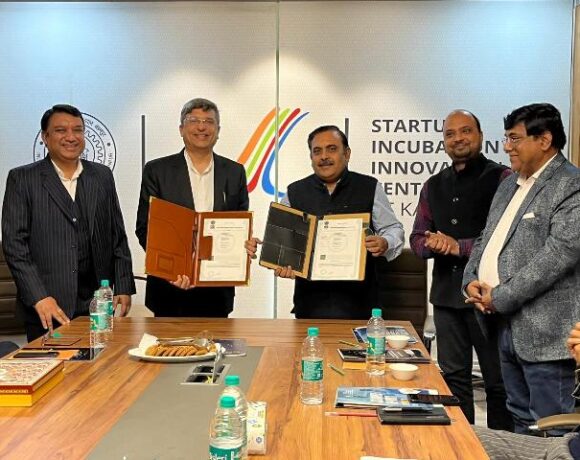A view from the right: Rising Sun and falling stars — Indian economy shines on ahead of budget
NEW DELHI, JAN. 31: Despite the slowdown in the global economy impacted by the pandemic, ongoing war, monetary tightening in advanced countries, India’s economy emerges as the fastest growing with a 6.8% projected annual GDP growth rate for FY 23 and is poised to occupy the position of the third largest economy by 2029, moving up from the 10th position in 2014.
In a comparative assessment of economies across countries, India emerges the strongest, here are some statistics: In 2022, India’s annual GDP growth was 7.4% while China recorded 3.3%, USA 2.3%, the advanced economies at large recording a 2.5% growth and developing economies just 3.6%. Equally reassuring are the 2023 projections of growth, with India at 6.1% compared with China at 4.6%, USA — 1%, advanced economies — 1.4%, developing economies 3.9%.
A close look at the survival indicators of food, shelter and energy between 2021-22 reveal that India fares better than US, UK and Germany.
On food prices, while countries like the US, UK and Germany recorded a 25%, 18% and 35% rise respectively, India managed to halt it at 12%.
Similarly on shelter prices while the US, Germany and UK saw increases of 21% and 30%, India recorded a mere 6% rise.
A similar trend was seen in energy prices, where UK and Germany recorded a rise as high as 93% and 62%, while India saw only a 16% rise.
Leveraging on our financial empowerment programmes for the poor, our per capita income has increased by 57% since 2014, while countries like Brazil and Japan have seen a decline in per capita incomes by 27% and 11 % respectively. While our neighbours Sri Lanka, Pakistan and Bangladesh are in economic turmoil and have approached the IMF for assistance, our foreign exchange reserves has surged to 550 billion USD.
In terms of demography too, we present a robust future with our population set to exceed China in 2050 fortified by reaping the demographic dividend of our youth and a higher share of the working age population.
While output and employment are projected to contract in the emerging and developing countries in the coming years by 4.3% and 2.6% respectively, India’s output and employment continue to grow with Morgan Stanley projecting the overall consumption in the country to more than double, from $2 trillion in 2022 to $4.9 trillion by 2030. Manufacturing’s share of GDP in India could increase from 15.6% currently to 21% by 2031-end, and in the process, double India’s export market share.
New investments in 2022 were to the tune of Rs 20 trillion, compared with 10 trillion each in 2021 and 2020 with an increase in private participation by almost 70%. High GDP growth also led to better-than-expected tax collections with our domestic GST collections reaching Rs 1.49 lakh crore at the close of 2022. Further, the banking sector with a credit growth of 17% last year is also healthy with low non-performing assets.
This economic success is primarily attributed to the strong foundation of progress in universal coverage of basic amenities through the well-implemented programmes of the Modi Government. A snapshot of the improvement indicators will highlight our progress. Through the Pradhan Mantri Awas Yojana there was an in increase in affordable housing from less than 5 million in 2015 to 25 million in 2022, tap water access has increased from 15% in 2015 to 45% in 2022 through programmes such as Jal Jeevan Mission and Amrut. Coverage of households with electricity access has increased from 52% to almost 100% through the Soubhagya Mission. The ubiquitous Ujjwala yojana benefitting more than 37 million women below the poverty line has increased the coverage of households with access to LPG cylinders, from 56% in 2014 to 100% today. The much-acclaimed Swacch Bharat Mission has increased the coverage of sanitation from 43% to 100%, thus transforming the sanitation landscape of our country to be open defecation free.
The digital transformation story which has enabled such massive coverage and financial inclusion has been the backbone of our progress. With over 650 million active internet users, the digital coverage has increased from just 20 per 100 in 2014 to 60 per 100 today. A Mc Kinsey study projects that by 2025, core digital sectors such as IT, business process management, etc could double their GDP level to $435 billion. Newly digitising sectors, including agriculture, education, energy, financial services, healthcare, government services and labour markets, could each create $10 billion to $150 billion of incremental economic value in 2025, the report says.
In the field of renewable energy too India has made remarkable strides reinforcing our Nationally Determined Contributions to UNFCC, with our power generation capacity increasing to 400 GW from 200 GW and in that the share of renewables increasing to nearly 40% from 25% in 2015. This growth in energy demand and transition from fossil fuels will throw up new investment opportunities. As per a CEEW report, India can create about 3.4 million jobs (short and long term) by installing 280 GW solar and 140 GW wind capacity as it moves towards accomplishing its goal of 500 GW non-fossil electricity generation capacity by 2030. The National Green Hydrogen Mission approved by the Union Cabinet in January with a total outlay of Rs 19,744 crore with the objective of making India the global hub for production of green hydrogen will definitely reinforce the efforts in the sustainable development path.
The World Bank in a report titled ‘Navigating the Storm’, finds that “while the deteriorating external environment will weigh on India’s growth prospects, the economy is relatively well positioned to weather global spillovers compared to most other emerging markets”.
Hence, our Union Finance Minister, while presenting the budget for FY 2023-24 on February 1, 2023 would be positioned relatively stronger amid a stable economic and macro environment, an outcome of her efforts over the last few budgets, through the turbulent times. While the budget 2022-23 was based on an agile approach, the 2023-24 budget could be keeping longer term goals in view. With the momentum of capital expenditure expected to grow aligned with the Atmanirbhar theme, the budget would see a balance between macro-economic stability and growth.
-TNIE







